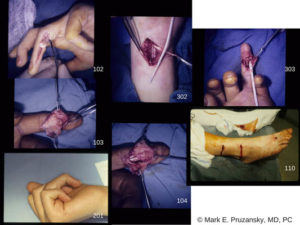Finger Flexor Tendon Rupture

Patient who experienced a finger flexor tendon rupture.
What is Finger Flexor Tendon Rupture?
Tendons are tissues which connect muscles to bone. When the muscle contracts, the tendons pull the bones which in turn cause the finger to move. The tendons located in the palm of the hand and fingers which bend your fingers are known as flexor tendons.
Each finger has two flexor tendons—the flexor digitorum sublimis (FDS) and flexor digitorum profundus (FDP). One of the flexor tendons—the flexor digitorum profundus—bends the fingertip.
This flexor tendon can rupture from its attachment to the fingertip when excessive stress is applied to it. This is the most common form.
Signs and Symptoms of Finger Flexor Tendon Rupture
Finger pain, reduced finger motion, and stiffness are common symptoms of a flexor tendon rupture. Additionally, the fingertip may not bend when attempting to make a fist and there may also be swelling and bruising of the finger.

Examples of chronic rupture and laceration of the flexor digitorum profundus tendon. Flexor tendon and sheath reconstruction, beginning with placement of a silastic tendon spacer, around which a new sheath forms, required for tendon gliding. After second stage flexor digitorum profundus reconstruction with tendon graft taken from the second toe, replacing the silastic tendon spacer, and progress during rehabilitation.
Injuries with a partial finger tendon tear to the rupture may make it difficult to flex the fingers. If the tendon has fully ruptured, the finger will not be able to fully close.
Other indicators include:
- Inability to bend one or more joints in the finger
- Pain when the finger is bent
- Swelling in the finger or palm
- Numbness in fingertip
Causes of Finger Flexor Tendon Rupture
In sports requiring arm and hand strength, such as football, a finger’s tendons and sheaths can be stretched and torn. In non-athletes, certain illnesses or an old injury in the wrist may weaken the flexor tendons, making them more likely to tear.
Often, a patient will suddenly notice the inability to bend their finger but cannot recall when it could have happened as finger flexor tendon ruptures aren’t always developed acutely nor are they always painful.
Injuries Associated with Finger Flexor Tendon Rupture
Finger flexor tendon rupture generally occurs when the fingertip is bent and significant force is applied to straighten it. This frequently occurs when grabbing a player’s jersey and the fingertip is yanked as the other player runs away in contact sports like football and rugby, hence the nickname, “Jersey Finger.”
The ring finger is most frequently injured, partly due to the fact that it is more interconnected with adjacent fingers.
Additionally, patients with advanced rheumatoid arthritis and some bony alterations of the wrist may also experience spontaneous flexor tendon rupture. The presence of plates and screws used in fracture surgery of the distal radius is a risk factor.
Treatment Options for Finger Flexor Tendon Rupture
A careful physical exam is essential to evaluate the status of all of the finger flexor tendons and the rest of the hand and wrist. X-rays are obtained to check for possible associated fractures because the finger flexor tendon can pull off bone fragments from the fingertip when ruptured. Other sources of friction are sought.
An MRI may be required to confirm the diagnosis and to assess how far the ruptured finger flexor tendon has retracted.
Patients with a finger flexor tendon rupture generally benefit from surgery to reattach the ruptured flexor tendon to the bone at the fingertip.
It is preferable to perform the repair as soon as possible. Depending on how much retraction of the tendon has occurred, and the length of time since the injury, the ruptured flexor tendon sometimes needs to be reconstructed with a tendon graft or transfer to allow reattachment to the fingertip and improved motion.
Conservative Treatments
In most cases, finger flexor tendon rupture requires surgical intervention because most ruptured tendons cannot heal properly on their own.
An experienced hand surgeon may place your hand in a splint for protection. NSAIDs may be beneficial in providing immediate pain relief.
Surgical Treatments
A torn tendon cannot heal without surgery. Ideally, surgery will be performed within 7-10 days after the initial injury. The sooner the patient receives surgical intervention, the better the results and long-term prognosis will be. Depending on the overall analysis longer periods of delay may be tolerated before a reconstruction is entertained.
Prognosis for Finger Flexor Tendon Rupture
Patients can expect some scarring to occur as the tendons heal. Many patients do not regain full range of motion.
Patients are expected to participate fully in occupational therapy immediately following surgery to reduce scar tissue and achieve better results.
If You Believe You Have Finger Flexor Tendon Rupture, Contact HandSport Surgery Institute
Please contact us as soon as possible to schedule an appointment with our talented team. People experiencing Finger Flexor Tendon Rupture should be evaluated to optimize their recovery.
If you have been injured, it’s important to be evaluated by a highly skilled professional. Call Drs. Mark and Jason Pruzansky at 212-249-8700 to schedule an appointment, obtain an accurate diagnosis, and start to restore comfort to your hand.

Examples of chronic rupture and laceration of the flexor digitorum profundus tendon. Flexor tendon and sheath reconstruction, beginning with placement of a silastic tendon spacer, around which a new sheath forms, required for tendon gliding. After second stage flexor digitorum profundus reconstruction with tendon graft taken from the second toe, replacing the silastic tendon spacer, and progress during rehabilitation.



